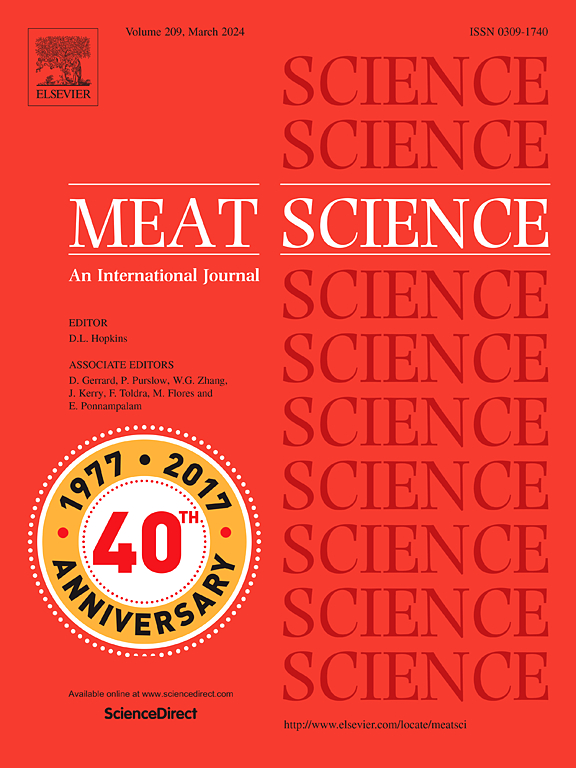瘦肉产量对澳大利亚羔羊食用品质的影响部分是由肌内脂肪驱动的
IF 6.1
1区 农林科学
Q1 Agricultural and Biological Sciences
引用次数: 0
摘要
评价了瘦肉产量(LMY)的提高对消费者食用接受度的影响及其与羊肉产品肌内脂肪(IMF)的关系。消费者感官评分(总体喜欢度、嫩度、多汁性、风味喜好)来自3119只羔羊,以及这些动物的一部分(n = 824)的指关节、腿、外部、肋骨、臀部和肩部。LMY指标包括GR组织深度(测量距离第12肋背中线110 mm)、胴体整体和剖面(前、鞍、后)计算机断层扫描(CT)、腰部和上部的瘦%和切重(占胴体总重量的百分比)。测量了所有动物的腰部IMF,并从一部分动物的上部、外侧、臀部和肩部获得了IMF。线性混合模型显示,除关节和腿部外,所有切口的LMY均随着LMY的增加而降低(P < 0.05)。对饮食质量的影响取决于用于估计LMY的方法,当使用CT瘦肉百分比测量时观察到最强的关联,特别是切片CT瘦肉百分比。LMY对消费者进食质量的影响完全由腰、臀部位内的IMF驱动(P > 0.05),而仅部分由腰、外侧和肩部的IMF驱动(P < 0.05)。结果证实了同时选择LMY和IMF作为羊肉食用质量的关键驱动因素的重要性,以及将LMY的在线预测纳入食用质量分级系统的重要性。本文章由计算机程序翻译,如有差异,请以英文原文为准。
The impact of lean meat yield on Australian lamb eating quality is partially driven by intramuscular fat
The impact of increasing lean meat yield (LMY) on consumer eating acceptance and its association with intramuscular fat (IMF) of lamb products was evaluated. Consumer sensory scores (overall liking, tenderness, juiciness, flavour liking) of the loin and topside were obtained from 3119 lambs, in addition to the knuckle, leg, outside, rack, rump and shoulder from a subset of these animals (n = 824). LMY indicators included GR tissue depth (measured 110 mm from dorsal midline of 12th rib), whole carcass and section (fore, saddle, hind) computed tomography (CT) lean% and cut weight of the loin and topside (as a percentage of the total carcass weight). Loin IMF was measured on all animals, with topside, outside, rump and shoulder IMF obtained from a subset of animals. Linear mixed models demonstrated a reduction in eating quality with increasing LMY in all cuts (P < 0.05) except the knuckle and leg. The impact on eating quality varied depending on the method used to estimate LMY, with the strongest association observed when using CT lean% measures, particularly section CT lean% from which the cut was taken. The effect of LMY on consumer eating quality was fully driven by IMF within the loin and rump cuts (P > 0.05) but only partially in the rack, outside and shoulder (P < 0.05). Results confirm the importance for simultaneous selection of LMY and IMF as key drivers of sheepmeat eating quality and the importance for the inclusion of on-line predictions of LMY in eating quality grading systems.
求助全文
通过发布文献求助,成功后即可免费获取论文全文。
去求助
来源期刊

Meat Science
工程技术-食品科技
CiteScore
12.60
自引率
9.90%
发文量
282
审稿时长
60 days
期刊介绍:
The aim of Meat Science is to serve as a suitable platform for the dissemination of interdisciplinary and international knowledge on all factors influencing the properties of meat. While the journal primarily focuses on the flesh of mammals, contributions related to poultry will be considered if they enhance the overall understanding of the relationship between muscle nature and meat quality post mortem. Additionally, papers on large birds (e.g., emus, ostriches) as well as wild-captured mammals and crocodiles will be welcomed.
 求助内容:
求助内容: 应助结果提醒方式:
应助结果提醒方式:


